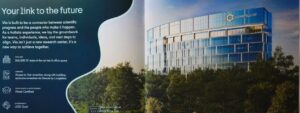(PCC) Program on Chinese Cities – Thoughts on Overseas Travels Series
Authors: Wang Yu,
Director of Planning and Urban Design at Beijing IRENM Design Consulting Co., Ltd. ichbinwangyu@yahoo.com
1 RTP’s future core project: HUB—A mixed-use development project initiated in early 2022
On October 24, 2023, the annual Halloween is approaching, bringing the festive atmosphere of this significant Western festival to streets and alleys. Visiting scholars from various cities in China (Shanghai, Beijing, Chengdu, Jilin, Zhejiang…) were fortunate to participate in the second tour of the North Carolina Industrial Park since October – the renowned Research Triangle Park (RTP, the first visit was to the American Tobacco Campus). It’s evident that the Halloween pumpkins here are as big as those in Chapel Hill, and the skull decorations are uniquely fun (Image 1), breaking away from the stereotypical impression of research office buildings. Later, we learned that this was part of the Boxyard commercial project—converted from shipping containers into a unique retail and restaurant community, and the only dining, shopping, and entertainment venue within the park (Image 2). Within the 40 containers, 15 retail brands operate, offering craft beer, Korean barbecue, and cupcake desserts (awarded the best in the Durham area: Lawrence’s Korean BBQ, Beyu Cafe, Fullsteam Brewery, Wonderpuff gourmet food)… there’s something for everyone!

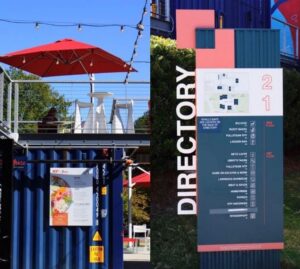
Years ago, during a new industrial park project inspection in Nanshan, Shenzhen, I had heard of the famous RTP. This visit, led by the park’s developer himself and attended by scholars from various industries, was a rare opportunity! Thus, I took the time to organize my thoughts and insights about the park, serving as a record of my visit.
Let’s look at the latest project being developed and constructed by the Research Triangle Foundation of North Carolina (RTF) in 2023—HUB’s master plan (Image 3). After gaining an overview, we’ll delve into its various functions.
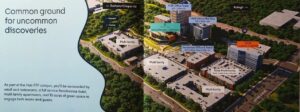
HUB is a horseshoe-shaped complex (Images 4, 5), serving as RTP’s future commercial and office center (mixed-use building), with a total area of 158,000 square feet (approximately 14,679 square meters), including 35,000 square feet (approximately 3,252 square meters) of retail space, tripling Boxyard’s size (Image 4). Additionally, there’s a beautiful 1-acre (approximately 4,047 square meters) courtyard.
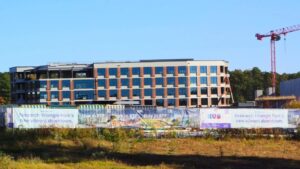
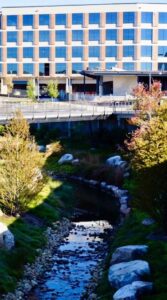
We curiously approached an apartment building under construction next to the complex, its unified color scheme and cement texture (Image 6) showcasing the simple style of North Carolina residents. The courtyard is planned to feature a swimming pool, adopting a garden home style. This was my first visit to a North Carolina construction site in 2023, but it felt very familiar (Images 7—9).
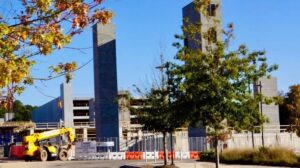
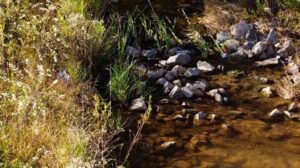
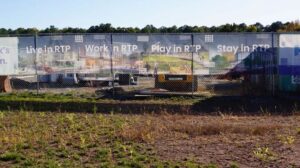
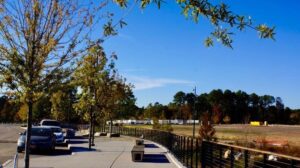
HUB’s project includes the Frontier “private offices” offering free Wi-Fi, coworking spaces, fitness, and professional development opportunities, providing office space for teams of 1 to 150 people (Image 10). The park features various sizes and styles of office spaces, with the lowest rent at $45 per square foot per month.
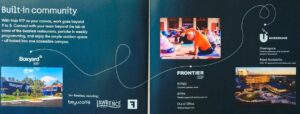
2 RTP’s Evolution from 1.0 to 3.0 and the Mission of the HUB Project
The tour was led by two staff members from the Research Triangle Foundation of North Carolina (RTF). The foundation appears to be a government agency but is actually a private, or rather, a non-profit organization. RTF’s primary mission is not to profit from taxes but to attract and retain talent, explaining its core location within RTP. The creation of such people-centric, mixed-use projects deviates from traditional industrial parks, reminiscent of the Philips open innovation park built in Eindhoven, Netherlands, in 1998, perhaps due to old office buildings’ inability to provide a high-quality modern work environment. Does the central park in HUB also encourage and attract park employees to leave their desks, step out of the office, and participate in community events, enjoying cultural exchange and intellectual collisions in nature? Maybe this marks the beginning of innovation.
The North Carolina government creatively defined RTP within a special tax district around Durham, allowing RTF to reinvest tax revenues into the park’s public infrastructure and recycle land sales funds into its operational management. With its unique governance and operational methods, RTF supports RTP’s future economic development, investing nearly $4 million annually in park construction. RTP, the second commercial park ever created in the U.S. after Stanford Industrial Park, faces a huge challenge due to the lack of completed projects for reference.
Founded in 1959, RTP spans two counties, Wake and Durham, covering 30% of Wake County and 15% of Durham County, and is centrally located among three Tier 1 research universities—Duke University, North Carolina State University, and the University of North Carolina at Chapel Hill, only 6 miles from Raleigh-Durham International Airport, making it a leading global innovation center (Image 11). The park spans 7,000 acres, about half the size of Manhattan, hosting 375 startups and 60,000 employees, 42% of which are minority- and woman-owned businesses. Regional transportation, affordable housing, equitable public education, environment, recreational facilities, Raleigh-Durham International Airport (Image 12), and infrastructure are also focuses of the park. RTF aims to attract the right investments to ensure the region’s attractiveness grows with RTP’s development. Managed by the North Carolina RTF, its long-term goal is to foster collaboration among universities in the Triangle area, between universities and industry, and to drive economic growth for North Carolina. As the park’s manager, RTF strives to create a prosperous business environment, promote economic development, and foster strategic partnerships between regions and states.
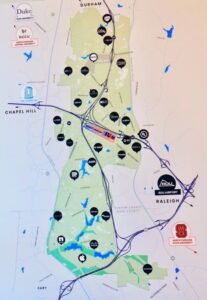
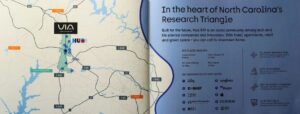
RTP’s biggest opportunity lies in the demographic “shock” expected by 2050, with the population increasing by 50% (from 2 million to 3 million). Typically, working in RTP doesn’t even afford the chance to grab a takeaway coffee, let alone enjoy dining and entertainment options. The pandemic has led to more employees working from home, and post-pandemic, this stalemate continues: office vacancy rates rise, while lab utilization remains relatively optimistic. This issue can be traced back to the initial planning sketch of RTP 1.0 in 1959, which designated vast areas as industrial land, excluding any commercial or residential use, making RTP a “workplace” surrounded by the Research Triangle Park community.
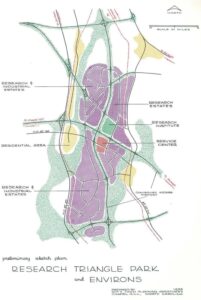
By fall 2021, RTP remained the metropolitan area with the highest proportion of remote workers in the U.S. Some companies in RTP originally had 12 office buildings, but now only 3 are in use. Finally, RTF realized the status quo must change. The efficiency and speed of the team, led by Travis, were evident in their presentation, showcasing their market research, economic and population data sharing between states, and benchmarking visits to various industrial parks in the Boston area, Washington D.C., Seattle, Silicon Valley, and the “original” industrial park, Stanford.
After completing site visits and gathering the latest data, RTP reached a pivotal moment with the launch of the HUB project, steadily moving towards the 2.0 stage. By the end of 2022, RTF staff had completed discussions with over 300 RTP companies in just over 100 days. RTF envisions the future park not just as a workplace, but as a community where doers and dreamers can integrate their interests into life, work, and entertainment. Whether it’s developing new cancer treatments at national labs or sharing locally brewed beverages at Boxyard, RTP’s industry structure is diverse and inclusive. In March 2023, the HUB mixed-use project officially began construction. Zoning changes (referred to as “adjusting regulations”) were challenging. The HUB project, with a total investment of $1 billion, spans 100 acres, including office, residential, retail, hotel, and green spaces. It will offer 1,200 residential units, 1 million square meters of customizable office and lab space, 16 acres of parkland, 50,000 square meters of retail space, and 250 hotel rooms (Image 14). Additionally, North Carolina’s “traditional project” includes over 20 outdoor hiking and leisure trails (How many trails have you visited near your home, visiting scholars new to North Carolina?).
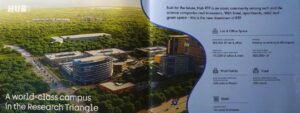
Today, the facades of the office and commercial complex buildings (horseshoe-shaped architecture) are nearly complete, the central landscape water system is gradually being finished, and one of the three apartment buildings has been topped out, all within just half a year. Our visit also marveled at the development speed, comparable to that of Chinese real estate developers. With the upcoming presence of Apple, the park is rapidly entering a new RTP 3.0 phase. The model evolution diagram (Image 15) reveals the thoughtful consideration of the managers, showing the need to cover various urban functions—a major challenge for park managers. The hope is that the HUB test project will provide them with more pioneering ideas, breaking away from the past and current status, facing challenges at any time. This is perhaps a principle RTP has always adhered to.
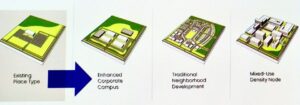
Improving transportation is also a significant task currently undertaken by the foundation. Although RTF is not a public entity, it plays a public role, thus establishing a close partnership with local governments. RTP Connect’s transportation subsidy is a collaboration between GoTriangle and RTP, offering a $10 subsidy per trip for passengers traveling within the RTP area, valid on weekdays from 6:30 am to 10 pm (trips must be booked before 10 pm). This highlights RTP’s rigorous yet humane management approach.
Additionally, RTP’s art projects have nurtured a new generation of local and regional talent, constantly making breakthroughs in imaginative, thought-provoking, and interactive media. RTP’s art represents a coexistence of media, computational technology, and architecture. As North Carolina RTF leads RTP into its seventh decade, integrating key elements like public art has created vibrant public spaces and facilities (Images 16—20), making RTP a leading innovation area and part of RTP’s overall strategy to adapt to changing dynamics. Public art will be omnipresent in future workplaces and the Triangle area’s growth-oriented development model.

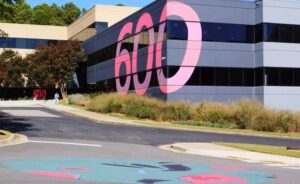
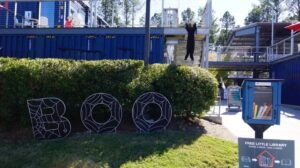
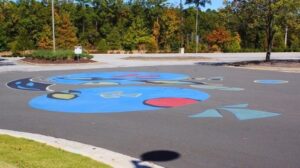
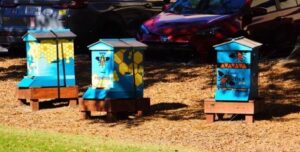
3 RTP’s Historical Review and Future Outlook
In the 1950s, North Carolina’s economy began to decline. In 1950, the state’s per capita income ranked 47th among the 48 states, relying on tobacco, textiles, and furniture manufacturing as a southern economy. College graduates left the state in droves in search of better jobs. Governor Luther Hodges then collaborated with government and industry leaders to devise a bold plan, giving rise to the initial concept of RTP.
In its first 25 years (1960—1985), RTP’s growth and development were characterized almost entirely by large companies like IBM and Burroughs-Wellcome establishing R&D facilities in the park. From then on, RTP became known as a favorable place for emerging research and technology companies. Local universities in North Carolina (Duke University, University of North Carolina at Chapel Hill, North Carolina State University) offered a wealth of untapped new disciplines and professional talents, along with a culture of intelligence and affordable living costs that scientists and technicians loved.
In the 1990s, the entire Raleigh, Durham, and Chapel Hill area, known as the “Research Triangle,” was influenced by a shift towards outsourcing research and clinical trials. RTP’s collaborative model once again played a crucial role—many took full advantage of the cooperation between Triangle universities (Duke University, North Carolina State University, University of North Carolina) and local companies like SAS, known for their statistical and analytical expertise.
In 2000, after the merger of Glaxo-Wellcome and SmithKline Beecham into GlaxoSmithKline, 61% of spin-off companies specialized in new drug discovery and medical device development. During the same period, RTP’s collaboration model added two important components: the North Carolina Biotechnology Center and the North Carolina Microelectronics Center. These organizations were among the first non-profit organizations funded by the national government in the United States, aimed at helping small companies succeed in the fields of life sciences and microelectronics.
Looking forward to 2050, North Carolina’s loans, grants, consulting, and networking policies will fully come into effect. The state has now entered the top three in bioscience employment in the U.S. and has become a world leader in vaccine research and manufacturing. It is the birthplace of the agricultural biotechnology industry with an annual output value of $86 billion, expected to play a significant role for the world’s population of 9 billion by 2050.
Today, RTP remains a model for industrial parks, being the largest in North America and arguably the most successful in the world.
Latest from RTP: Apple has begun constructing a new campus in RTP, expected to be completed in three years, providing 1 million square feet of office space and 3,000 jobs. The U.S. FDA has approved Eli Lilly’s development of the COVID-19 antibody drug, Jaguar Gene Therapy, with a $125 million investment in RTP to create a production base providing 200 jobs.
During this event, visiting scholars engaged in discussions with RTP developers and operators, gaining firsthand information about the Research Triangle Park, improving their English listening and speaking skills, and receiving RTP LOGO-printed T-shirts, USB drives, and brochures as exquisite gifts, instantly enhancing the happiness of their visiting experience. We look forward to more visiting scholars participating in such exciting events and experiencing these wonderful corporate interviews firsthand!

